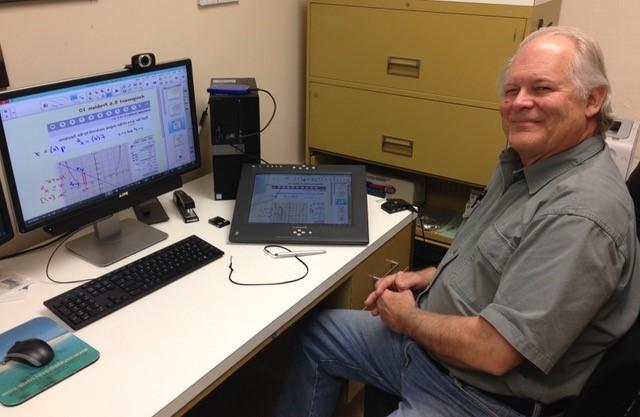Digital tools help CSC math teachers adapt to online instruction

CHADRON – A personal touch can help students in college classes master mathematics, a subject many find daunting, according to Phil Cary, a 16-year veteran faculty member in the Chadron State College mathematical sciences department.
But making those individual connections with online students, who make up an important component of CSC’s math courses, can be difficult, so instructors have adapted a variety of technological tools to give those students personalized instruction that allows them to be successful, Cary said.
Chadron State began offering math classes online in 1997, under the direction of then-math department head Dr. Monte Fickel. In 2003, CSC became one of the first accredited colleges in the United States to offer a bachelor’s degree in math entirely online. While many more schools now offer mathematics major degrees online, Chadron State’s online math program is highly ranked nationally for quality and affordability.
Cary spent 21 years as a high school math and physics teacher before joining the CSC faculty, and has been teaching math online since he started at the college.
“By the time I got here, they had pretty well established the math program online,” he said. “We have had a number of students who have gone clear through and earned their bachelor’s degree with a math major entirely online. They would sometimes come for the graduation ceremony and that would be the first time you would see them in person.”
Chadron State’s online math classes attract significant numbers of students from nearby places, as well as locations around the world. Last semester Cary had a student taking a class from Pakistan and one from Japan, along with others from across the U.S.
“I might have 10 to 15 (students) on campus and an equal number off campus,” he said. “It has really enlarged our classes quite a bit.”
One challenge in teaching CSC math courses is that both online and on-campus students are combined in a single class, Cary said.
“What we do here is kind of unusual. We teach one course, but have in class both online and on-campus students, which means you are teaching to two different audiences,” he said.
Cary said he and other CSC instructors have developed various strategies to give both sets of students the same quality of instruction. He prepares extensive notes for his classroom discussions, and then provides them in written form to online students. In addition, he makes an audio recording of the classroom discussion available for his online students.
“Sometimes they (online students) just want to see the notes but if they get lost in something, they have the audio discussion as well,” Cary said.
The extensive use of symbols in mathematics poses another challenge for teaching online.
“Much of our communication is done in symbols that aren’t used anywhere else,” Cary said.
While programs exist that create math symbols on a traditional keyboard, using them can be daunting to a novice.
“It’s time consuming and a steep learning curve,” said Cary. “That causes some difficulties in the freedom with which we communicate with off campus students.”
To address that problem, Cary said he encourages students to email him questions.
“If I can respond in an understandable manner with text, I will, but quite often I make a short video with screen capture software and my voice,” he said. “I send that video to them. It’s like I’m sitting down with them. The only thing I don’t get is their feedback.”
One advantage of creating the explanatory videos is that they can be used repeatedly, Cary added.
“Once I’ve made one of those, I can show it to other students if they need it as well. That has worked out pretty well.”
Another successful adaptation for online math instruction, that is also helpful for on-campus students, is the use of specialized programs that give students homework problems to solve and tells them if they have the correct answers.
“They get feedback right away and don’t have to wait to send their work to me to grade it and send it back,” he said.
Those programs, which can include video clips, are particularly useful for non-math majors taking introductory level courses, who may feel insecure in their math abilities, Cary said.
“They can come to class and listen to me and if they still don’t get it, go back and listen to the video and try the problem.”
Even with a variety of digital tools, there are aspects of in-person math teaching that Cary said he finds it difficult to replicate online.
“I like to get feedback from students-visual cues, facial expressions, even just a dazed look like ‘I’m not getting any of this,’” he said. “You can’t get any of that feedback online. I miss that aspect of it.”
Cary said he loves the logic and precision of math, finds beauty in the way it can accurately describe all sorts of natural phenomena, and really likes teaching the subject.
“There is something very enjoyable about communicating with another person with these abstract thoughts,” he said. “Just helping someone understand something in math is very enjoyable.”
Category: Campus News, Mathematical Sciences

